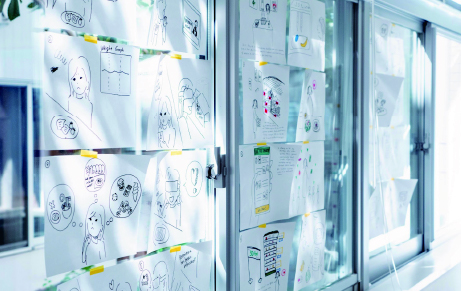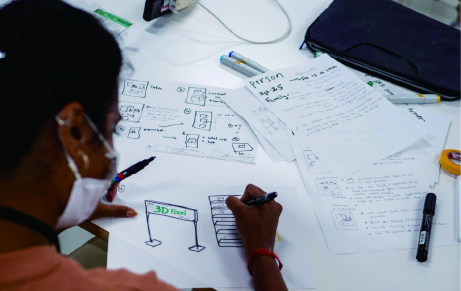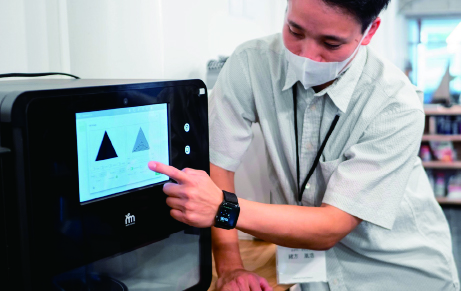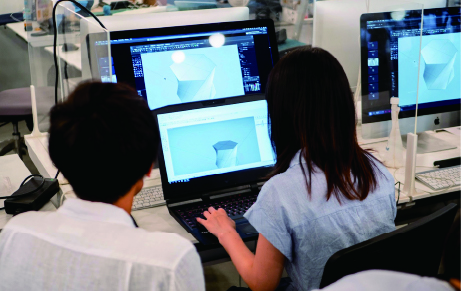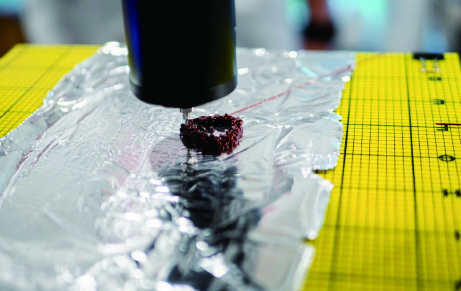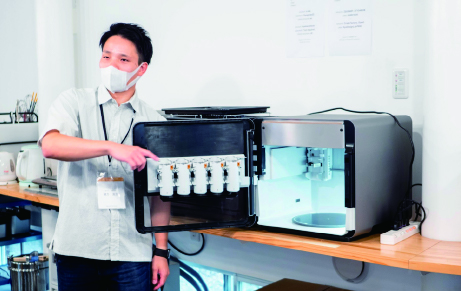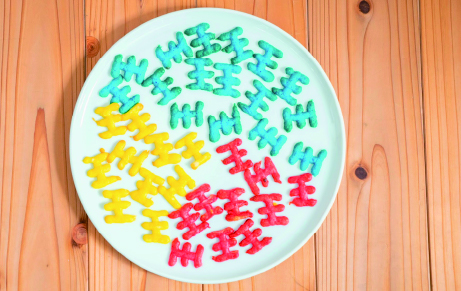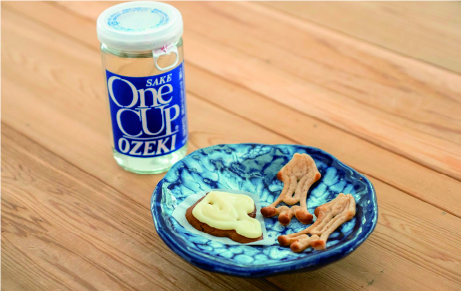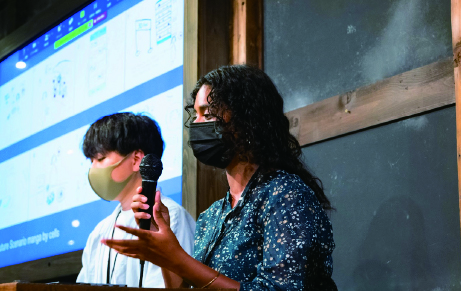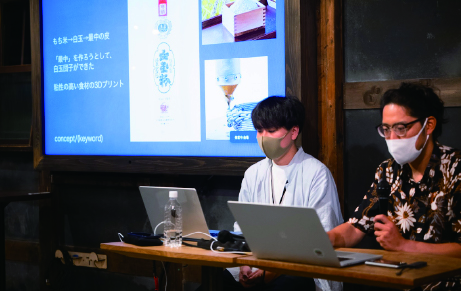Event report
November 28, 2022
From August to September 2022, the KYOTO Design Lab [D-lab] hosted the “School of Food Futures“, a five-day summer course for practical learning about sustainable future design, including digital food, algorithmic design, and circular design.
This article is a report on the School of Food Futures, which consisted of offline workshops and online lectures with guest speakers active in Japan and abroad to learn about cutting-edge trends in food, product, and circular design innovations. (text: Makoto Ishii [Loftwork])
What exactly does ‘food design’ design?
At the start of the School of Food Futures, facilitators Daijiro Mizuno and Kazuhiro Ogata gave a lecture overviewing ‘food design’, in reference to their co-authored book FOOD DESIGN: design research exploring future foods.

The book includes advanced examples of food-related technologies and services, as well as research processes aimed at shaping culture. In illuminating the methods and role of food design, the book presents the ideas and practices of ‘food design for the future,’ which proposes possibilities for uncertain issues. The summer school was based on their research.
In addition, as various issues are currently emerging in our food environments, such as climate change, population growth and food export restrictions related to conflict issues, a series of technological developments known as food tech and sustainable food development, represented by entomophagy, are also attracting increased attention. In order to create new food systems, services and foodstuffs, it is now required not only to acquire traditional food knowledge and skills, but also to question the preferable food for humans and the planet, and to design a food culture without precedents.
Offline Workshops
In the offline workshops held at the KYOTO Design Lab [D-lab], student members supported each participant in both creativity and technical aspects. Teams learnt about ‘algorithmic design for creating new food textures using Rhinoceros+Grasshopper’ and ‘design in the circular economy,’ while also experimenting with ‘3D printed chocolate’ and the ‘output of various materials using a food 3D printer’.Prototyping was also carried out at every session.
- 8/29(Mon) Ice break, Lecture, Food 3D printer exercise, 3D modelling exercise
- 8/30(Tue) Circular design exercise, Food 3D printer exercise, Speculative design exercise
- 8/31(Wed) 3D data creation, Prototyping using food 3D printer
- 9/1(Thu)3D data Creation, Prototyping using food 3D Printer
- 9/2(Fri) Final artefact fabrication, Tasting session
▲In the offline workshop, participants studied the actual operation and properties of the food 3D printer, while in parallel they referred to a vast amount of materials related to ‘food design’ to generate ideas for their prototypes using the ‘speculative design’ method.
▲Digital modelling was generously supported by student members and D-lab staff to achieve the shape envisioned by the participants.
The 3D printer used to fabricate chocolate was a customised version of a commercially available machine.
▲While prototyping based on the “speculative design” method, various future insights were referred to, and each participant gained insight into possible futures from the perspective of “food”. They also found out what kind of food was possible for that future from their own backgrounds and everyday life narratives.
▲Food 3D printer prototyping was conducted every day in parallel with the lectures. Having learnt the perspective of ‘circular design’, many participants worked not only with commercial powdered products but also processed and blended vegetable and fruit peels as well as dry foods.
▲Two different types of food 3D printers were used in the course. After a lecture on basic usage, there was also a tutorial on the creation of jigs, cooling methods and many other knowledgeable ‘tips’ to create the desired shapes during the prototyping process.

▲With the support of the D-lab staff, participants,created ‘moulds’ in analogue/digital ways in order to achieve the desired shapes and structures.

▲The materials and equipment used were all related to food, so the lively and enthusiastic scene of prototyping was like the kitchen of a popular restaurant.

▲Unique prototyping was carried out for chocolate, which has been shrinking in size over the years. The approach was to maintain the size without changing the pleasant experience of eating chocolate through designing its ‘structure’.

▲On the final day, a tasting and presentation were held at FabCafe Kyoto, where the participants discussed the final artefacts, including their production processes, and future development and possibilities.


▲Offline lectures were also performed by guest lecturers Ryosuke Wakasugi (CEO, Byte Bites Corporation) [left photo], Daijiro Mizuno, Kazutoshi Tsuda, Tomohiro Inoue [right photo] and Kazuhiro Ogata [central photo]. The image shows the presentation at FabCafe Kyoto on the final day.

The online lectures were conducted with the aim of taking a broader view of ‘food design’, inviting guest lecturers active in Japan and abroad in addition to the guest speakers of the offline lectures, and providing further opportunities for Q&A and exchange in addition to the talks and presentations.
8/28(Sun) “Introduction” by Kazuhiro Ogata and Daijiro Mizuno
…Introduction of Summer School / Introduction of Lecture Speakers / Introduction of how to use the Q&A in advance of the lecture / Introduction to Food Design / Relationship between food, design and digital fabrication, future prospects and challenges
8/29(Mon) “3D Food Printing” by Ryosuke Wakasugi
…Introduction of Byte Bites activities / Current situation of 3D food printing / Demands from society as identified through entrepreneurship / Personalization of food and the possibility of well-being
8/30(Tue) “Entomophagy” by Shinjiro Saeki
…Insects have been found to be a “common food” / The flip side of Laos’ rich entomophagy culture and malnutrition / Understanding the SDGs philosophy and practice through entomophagy / For whom should entomophagy be “designed”?
8/31(Wed) “Circular Design” by Kota Machida
…Food and the distribution industry / Building a “House of Sweets” / Introduction of activities as fabula
9/1(Thu) “Food and Ethics” by Kazutoshi Tsuda
…Introduction of YCAM “Food and Ethics Research” / Introduction of case studies on food and biotechnology / Introduction of a budding case study on circular design for food
9/2(金) Presentation by offline workshop participants, with Kazuhiro Ogata, Daijiro Mizuno, and Kazutoshi Tsuda
…Presentation of the final products / Possibilities and issues seen in the experiment of using food 3D printer / Tasting session, report on actual food
Taking advantage of the online platform, the lectures were a great opportunity to gain insightful perspectives from leading-edge practitioners in various fields. Once again, a wide range of fields encompassed and connected by ‘food’ and the many challenges and possibilities for the future were visualised. This report presents a small part of the guest lecturers’ sessions. (*All the following texts are a summary of the discussion points from the author’s point of view).
Ryosuke Wakasugi
CEO, Byte Bites Inc.
Topic: Where we are now in 3D food printing
1. Demands from society as identified through entrepreneurship
In the past years of exploring solutions to social issues using fabrication such as food 3D printers, demand has emerged that food 3D printers can be used for ‘distributed production’ to share food experiences and to give food a certain ‘textural feel’.2.Personalisation of food
In a society that is becoming increasingly data-oriented, the personalisation of ‘food’ and the demand for it is likely to progress. There is a shift from ‘food’ for overcoming hunger to ‘food’ for expressing one’s personality (e.g. vegan/fasting).3. The well-being potential of food
‘Diversity’ is behind what food can bring; it is possible to be exposed to different values and sensibilities through food. Potential exists for more than just an efficient supply of nutrients.。
Shinjiro Saeki (Chief Director, Japan edible science laboratory)
おいしい昆虫生活®
Edible Insect Science Meeting(e-ism) board chairman
Topic : For whom should entomophagy be ‘designed’?
1. Reinventing insects as ‘common food’
Adults tend to be ”presidentialist”. It is normal for adults to feel resistance to insects they did not eat in childhood, but if they use this intuition to imagine the future, they will be out of step with younger generations and different cultures. Not to mention that nutritional analysis of insects has progressed, and they have been approved as a common ingredient in the EU. Furthermore,children in Japan who love insects are now interested in entomophagy, saying that they also want to know what they taste like.2. Rich culture of entomophagy and malnutrition in Laos
In rural Laos, wild foods are consumed on a daily basis, including a wide variety of insects. By promoting the cultivation of weevils, which contain high levels of nutrients, oils, and fatsthat are often lacking in their lives, they are developing an agricultural method that circulates while reducing land degradation and other problems. This farming method is being implemented in collaboration with health administrations and NGOs to help solve long-standing child malnutrition.3. Understanding the philosophy and practice of the SDGs from the perspective of entomophagy
In Japan, wider attention is focused on goals that are more familiar to people and developing countries do not receive much consideration, but essentially, developing countries are the main actors. Developed countries cannot fulfill their obligations simply by working on one of these goals. Poverty eradication is the biggest challenge, and we need experts who can think of 17 goals in an integrated manner, and small, sustainable problem-solving sites, that is, ‘design for the developing world’, will lead to the future.
Kota Machida
CEO, fabula Inc.
Topic: Food and the venous industry
1. Challenges for food and the food industry
Not all food waste can be converted into fertilisers, and approximately 80% of food waste is currently disposed of as valueless waste. It is essential to create a ‘new story’ (value) from ‘waste’ by re-imagining the consumer and their role.2. Building a ‘House of Sweets’
Materials made by crushing and compressing food waste are strong enough to be used as construction materials. In addition, there are possibilities to use this material differently from other conventional materials in terms of sensory aspects such as ‘appearance’, ‘aroma’ and ‘taste’.3. Prospects for products made from food waste
fabula manufactures a wide range of products made from food waste. The company has already produced cutlery and even objects as big as furniture, and is in the process of collaborating on plans to use it in large-scale buildings.
Kazutoshi Tsuda
Junior Associate Professor, Center for the Possible Futures, Kyoto Institute of Technology
Yamaguchi Center for Arts and Media [YCAM], Yamaguchi City Foundation for Cultural Promotion
1. Food and ethics
How can we make ‘food as a system’ better? In particular, how can we assess and reduce its impact on the environment? How to incorporate ideas such as ‘regeneration’, ‘commons’ and ‘care’ into the food system for the post-growth era? We can learn about food and ethics through collaborations with artists, books and films.
2. Food and biotechnology
This session included a lecture series on food from perspectives such as ‘agri-bio-kitchen’, workshops on fermented micro-organisms and local food in collaboration with farmers and researchers, and a ‘genome lunch box’ project using only organisms whose genomes have been decoded as ingredients, to explore the possibilities of biotechnology starting in the kitchen.
3. Food circular design
Introduction of emerging examples of ‘circular design for food’, such as ‘augmented ecosystem’ in which diverse plants are cultivated to grow crops while creating ecosystems, and ‘meat substitute’ initiatives based on cell culture.
Both offline and online, the course provided many lecturers’ and participants’ perspectives on what lies on the vast and yet unexplored plains of the new field of ‘food design’.
In the final presentation, one of the lecturers commented: “I was already aware that circular design was not just about utilising waste foodstuffs or circulating only in urban areas, but this course made me realise once again that we should consider the fact that food originates from natural ecosystems.” It was also mentioned that the overall program served to highlight the existing connections among various ecological cycles, actor networks, and multi-species, as well as to provide diverse insights into the nature of personal fabrication.
Some participants mentioned that the characteristics of food ingredients affected the modelling of food using 3D printers, and that it was a difficult factor to manage, while the organising team also encountered challenges when prototyping because “the state of the ingredients changes during printing” and “there are more variables than expected”.
However, despite the selection of ingredients that were not limited to versatile items such as chocolate, the final artefacts presented the shape and texture that each team was aiming for.
Rather than taking a passive stance, lecturers, participants and student support members thought and discussed as a ‘team’ in response to numerous trials and errors. Thanks to their enthusiasm to “create something that has never existed before”, other than simply an experience of a new digital device, the program ended with an overall high level of satisfaction
“Food” is not a constant nor predictable variable. It changes in accordance to the evolution of human life, and exists as an issue that transforms depending on each recipient and place. In the future, we might witness how ‘the available choices’ expand in line with the expansion of the act of ‘eating’ itself.
We hope that the activities of the School of Food Futures will continue to broaden our horizons so that we can learn more about the ‘choices’ we can make and with whom we can practise them.
Date | Sunday, August 28 – Friday, September 2, 2022. Only online lecture on 28th.
Place | Kyoto Institute of Technology KYOTO Design Lab (1 Matsugasaki Hashigami-cho, Sakyo-ku, Kyoto, Japan)
*Only the final day, FabCafe Kyoto (554 Hon Shiogama-cho, Shimogyo-ku, Kyoto City, Kyoto Prefecture).
Capacity | 10 for offline workshop, 200 for online lecture
Participation fee | ¥100,000 for offline workshop, ¥10,000 for online lecture
Organiser | Kyoto Institute of Technology, KYOTO Design Lab[D-lab]
Collaborators | MTRL・FabCafe Kyoto
Event URL | https://www.d-lab.kit.ac.jp/events/2022/school-of-food-futures/
-
FabCafe Kyoto
This articles is edited by FabCafe Kyoto.
Please feel free to share your thoughts and opinions on this article with us.
→ Contact usThis articles is edited by FabCafe Kyoto.
Please feel free to share your thoughts and opinions on this article with us.
→ Contact us


